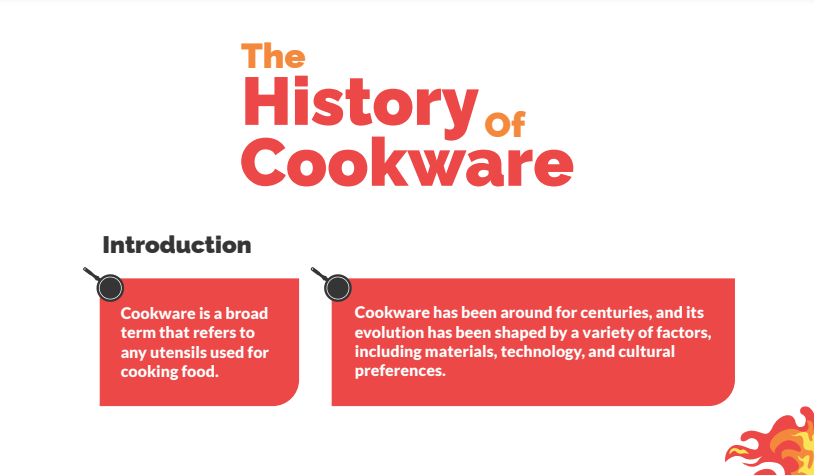What is the the history of cookware?
It’s easy to take for granted the conveniences of the modern kitchen: gas and electric ranges, stainless steel pans and utensils, and efficient options for refrigeration and reheating. We don’t often have to give a moment’s thought to what kind of vessels we heat our food in, except to make sure that we don’t put anything metal into the microwave.

As recently as 100 years ago, choosing the right cookware meant understanding which foods were likely to interact with certain metals, and which combinations might be corrosive or even toxic. It’s a fascinating history that can teach us a lot about the tools we use today.
Let’s take a step back to see how cookware has developed over thousands of years to bring us the pots and pans that we use in modern kitchens, both at home and in restaurants.
 What is cookware?
What is cookware?
So what is cookware, how do we define cookware? How does it differ from bakeware and other vessels that we might use in the course of making a recipe? Specifically, cookware refers to vessels that are designed for use on a stove: saucepans, frying pans, skillets, woks, stockpots, kettles, griddles, and more.
Bakeware refers to tools that are used in the oven, such as cake and muffin tins, cookie sheets, pie pans, and roasting pans. Some vessels can be used either on the stove or in the oven, like the casserole pot, which can handle a variety of cooking methods.
A complete collection of cookware and bakeware is known as a batterie de cuisine, or “kitchen artillery” in French, and can be found in many professional kitchens. Other appliances, such as refrigerators and ovens, aren’t typically included under the umbrella, although the development of the range played a major role in the evolution of cookware.

What were the first cooking pots?
There’s some debate among historians over when the first cooking equipment appeared on the scene. While boiling a pot of water on the stove sounds simple to us today, it wasn’t necessarily intuitive to the first cooks sitting around an open fire.
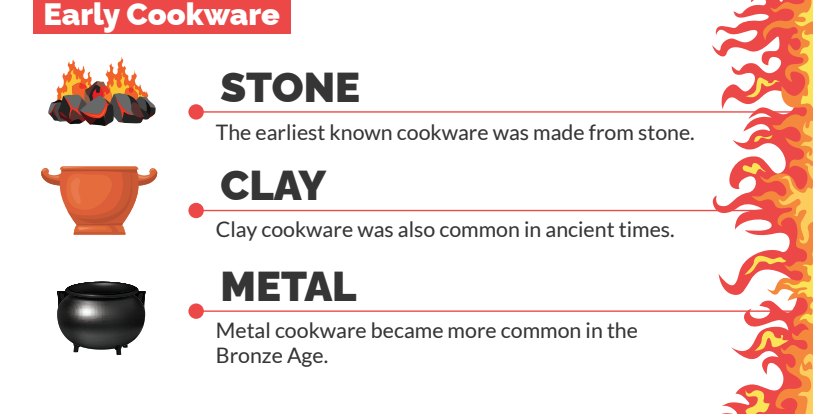
After all, many “natural” cooking vessels, such as shells, are too small too contain much liquid, while hard gourds may not have been sufficiently waterproof or heatproof. Consider the Fork: A History of How We Cook and Eat, Bee Wilson writes that the first true boiling method might have involved using animal stomachs, similar to the Scottish dish haggis, a traditional meat pudding that’s encased and boiled in a sheep’s stomach lining.

When did humans start cooking by boling water?
Around 30,000 years ago, humans developed hot stone cookery, which involved heating stones in a fire before dropping them into a pit filled with water. Once a large enough quantity of stones were added to the pit, the water would start to boil, and the pit could be covered with leaves or animal skins to retain the heat. This had the advantage of separating the cooking area from the open flame, which was safer for the cook and reduced the likelihood of setting the cooking vessel on fire.
Early versions of hot stone cookery may have used baskets, but the really important innovation was the invention of ceramic pottery. Pottery made it possible to cook soups, stews, and other dishes that required a stable, waterproof container that could be used repeatedly.
Some of the dishes we make today, such as pasta or rice, would be difficult to cook using the hot stone method, but for slow cooking meats and vegetables, it was ideal. In fact, it wasn’t just a culinary step forward, but a major boon for human health too. Before the adoption of cooking pots, getting enough to eat required lots of chewing. As Bee Wilson writes, “If you couldn’t chew, you would starve.”

When did we start using ceramic pottery?
Ceramic pottery made it possible to lose your teeth, and still be able to eat: “Pottery enabled our ancestors to make food of a drinkable consistency: porridgy, soupy concoctions, which could be eaten without chewing. For the first time, we start to see adult skeletons without a single tooth. The cooking pot saved these people.”
Not only that, but hot stone cookery allowed for the consumption of additional nutrients. When the inhabitants of Mesoamerica used limestone rocks to heat up their water (beginning around 1200-1500 B.C.) it interacted with maize to reduce toxins and release nutrients. This process, called nixtamalization, is still used to process corn for tortillas and tortilla chips today.
Other regions also benefited from expanded cooking options. In South America, writes Wilson, “once it was possible to boil cassava in a pot, it went from useless toxin to valuable staple, a sweet fleshy source of calcium, phosphorus, and vitamin C (though little protein).” By boiling them for hours at a time, toxic and indigestible plants were suddenly on the menu -- which hadn’t been the case when the only option was to roast them on an open flame.
Speaking of menus, where can we find the first recorded menu in history? It may have been this ancient recipe found on a stone slab in Mesopotamia, dating to 4644 B.C. Archaeologists have translated the cuneiform writing so you can recreate the recipe in your own kitchen. What does it make? A simple vegetable broth, likely made with animal fat and beets.

When did we start using metal cooking pans?
The next major step forward in the history of cookware was the development of metal cooking instruments. While copper tools have been around since at least 9000 B.C., it wasn’t until the Bronze Age, around 3000 B.C., when metalworking techniques had advanced enough that it became possible to make specialized cooking pots and cauldrons.
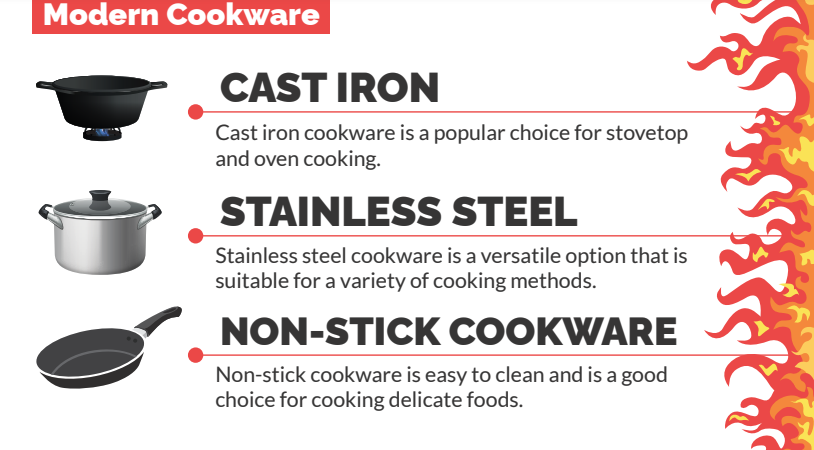
The ancient Romans were the most inventive, creating metal colanders, steamers, frying pans, and more. They experimented with various metals, and spearheaded the process of frying fish in oil -- in a large, flat pan called the patella, the precursor to the Spanish paella.

Did the romans invent metal cookware?
Metal cooking pots were superior to pottery in many ways, not least because they were more durable and could be placed right above the fire without breaking. But they were also easy to clean, and could conduct heat more evenly. The downside to metal pots is that they were very expensive to produce, and in large parts of Europe, they remained in limited use for many centuries. After the fall of the Roman Empire, many cultures stuck to the essentials: a metal cauldron, and a spit for roasting meat, both of which could be used over an indoor hearth. The Battersea Cauldron shows just how durable metal cooking pots could be. This bronze cauldron was discovered in the River Thames in 1861, but dates back to 800 B.C. Now, it’s housed at the British Museum in London. The cauldron is 15 inches high and can hold up to 70 liters (18 U.S. gallons). It’s made out of seven separate pieces of bronze that have been riveted together. It has a flared opening and two handles, and would have made a stunning centerpiece in any kitchen.

How did familys cook in the metal ages?
A cauldron might cost 50 times as much as an earthenware pot, so many of the medieval cauldrons that have been discovered show signs of repair. Tinkers, or traveling metalworkers, would roam the countryside using molten solder to patch holes in leaky cauldrons. The cauldron was used to make the original one-pot meal -- primarily variations on stews and porridges -- and could be swung on a crane over the fire to control the temperature. Still, cooking over an indoor fireplace was dangerous work. The heat was unbearable, a cook’s clothes could easily catch fire, and the smoke inhalation alone could be deadly. That’s why the next major invention in the history of cookware was such a lifesaver -- and could still save lives if were used more widely in developing countries today.

When was the indoor range invented?
The modern range, or stovetop, is a major part of what makes cooking not just tolerable, but fun and enjoyable for today’s home chefs. It wasn’t inevitable that it would turn out this way. Even in wealthy homes in the Victorian Era, homeowners were rarely found in the kitchen. In fact, the concept of a “kitchen” is a recent phenomenon. English country houses had several different rooms for food preparation, such as a dry pantry, a larder, a smokehouse, and a dairy. Rooms for cooking had to be built some distance apart from rooms for cooling, and might even be built in a separate facility, to avoid the risk of setting the whole house on fire. Cooks and maids specialized in different aspects of food production, not unlike the delegation of duties in a modern restaurant kitchen. It wasn’t until the development of the closed range, by Benjamin Thomas (also known as Count Rumford) in the 1790s, that it became possible to bring all of the components of the kitchen into a single room, in which multiple cooking surfaces were heated to a “range” of temperatures. His design managed to contain the flame within a stove and direct the smoke into a chimney, (later deemed the range hood) making kitchens safer, less unbearably hot, and more energy efficient. Closed ranges caught on during the Industrial Age, allowing roasting, baking, frying, and even boiling water to become commonplace in the home kitchen. Instead of wood fires, closed ranges could be heated with coal, which was cheap and widely available. Many of them were made with cast-iron, which was also used for pots and pans. Kitchen ranges became even more efficient when they transitioned to gas burners and electric ovens, both of which became widespread in the early 1900s.

When was the wok invented?
While European cooks were making slow, one-pot meals in cauldrons, Chinese cooks had been mastering another type of metal cooking pot: the wok. Although made from similar materials (usually cast-iron or steel), the wok had a different shape than pans used elsewhere in the world: a rounded floor with gently sloping sides, in contrast to the deep, vertical sides of skillets and saucepans.

What is the best pan for stir fy?
Why did these pans develop differently? One reason is that European cooks had plenty of fuel -- including coal and firewood -- to keep a consistent flame, so they didn’t have to worry so much about fuel efficiency when making a slow-cooked roast or a stew. China, on the other hand, didn’t have the same abundance of firewood, so its traditional cooking methods were designed to cook food quickly while using the least amount of fuel possible. This quest for efficiency even extends to the traditional Chinese cooking knife, the rectangular cleaver known as the tou. While Europeans developed knives for every occasion -- paring knives for fruit, carving knives for meat, and so on -- the tou could be used to cut up everything, meat and vegetables alike, into tiny, even pieces that could be stir-fried to perfection in the wok. Another piece of traditional Asian cookware that still sees widespread use today is the dolsot, a round bowl use to cook and serve popular Korean foods like bibimbap. Made out of agalmatolite, a type of soapstone, it’s designed to keep the meal hot while eating it, and contributes to the iconic crust of rice that forms at the bottom of the dish.

If there’s one country that’s had an outsized influence on modern cooking technology, it has to be France. In 1795, Napoleon offered a prize of 12,000 francs to anyone who could find a way to safely preserve enough food to feed the French army. The reward went to Nicolas François Appert, who figured out how to preserve food by canning it in glass jars.

Interesting facts about Napoleon
French chefs also pioneered the use of copper cookware, devising specialized equipment for any dish imaginable. Gone were the one-pot meals of medieval cauldrons. Instead, chefs assembled a batterie de cuisine, full of stewpans, saucepans, and stockpots of all shapes and sizes. Rather than fitting their ingredients into whatever equipment they had on hand, French chefs could choose the precise piece of cookware they needed for each recipe. This flexibility allowed for an explosion of sauces, emulsions, and of course, desserts, that had been difficult, if not impossible, to produce until now. Pots and pans in the batterie had exactly the right handle, lid, shape, and volume for their particular use.

What is sous-vide?
What makes this item so memorable? Aside from the eye-catching colors, the material that it’s made of gives it some unique properties that few other pieces of cookware have. For one, it offers the evenly-distributed, high heat of cast iron, but with an enamel coating that makes it easier to clean and doesn’t have to be seasoned. And unlike ceramic casserole dishes that can shatter in the oven, it can be used safely both in the oven and on the stove, making it perfect for soups, stews, and casseroles. Finally, French restaurants also popularized one of the most modern cooking methods of all: sous-vide, which translates to “under vacuum”. In this method, food is placed into a vacuum-sealed plastic bag and submerged in a bath of low-temperature water for several hours. Because the temperature can be precisely controlled, and because the ingredients are cooked in their natural juices, it’s known for producing tender, flavorful meats and vegetables. When it comes to steak, though, the best results are a mix of sous-vide cooking followed by grilling or searing. This is what produces the Malliard reaction, a chemical reaction between sugars and amino acids that leads to “browning” and a crispy texture.The Malliard reaction occurs not just in meat, but in many foods that contain sugars, including dumplings, fried potatoes, breads, and even toasted marshmallows. In any case, sous-vide machines are bulky and expensive enough that they aren’t commonly found in many household kitchens. But if you’re determined to try it, you can make your own DIY sous-vide equipment out of a standard beer cooler and a thermometer.

Should I season a cast iron pan?
The Malliard reaction is just one example of how the surface you cook on can make a major difference in the taste and appearance of your food. While we may think of our cookware and our food as being entire separate things, in reality, there’s often a chemical reaction going on between the foods that we eat and the pans that we cook them in. For example, clay pots are typically made of a porous, alkaline material that can help reduce the acidity of certain foods cooked in them, leading to a sweeter-tasting stew or casserole. This only works if the clay pot hasn’t been glazed or enameled, however -- which is why many cooks prefer unglazed clay pots for a slow-cooked Moroccan tagine. Another common reaction occurs when cooking acidic foods in cast-iron pans. Because these pans are made of, well, iron, they may be leaching small amounts of iron into your dinner. For vegans and for people with anemia, this can be a good thing -- it’s a bona fide way to get more iron into your diet, although it’s not the easily-absorbed type of iron found in meat. People at risk of iron overload, however, should be careful. Using a well-seasoned cast-iron pan can reduce the amount of iron that leaches into food, as does avoiding cooking acidic and liquid foods in them, such as tomato sauces and wine.

This handy chart offers a great visualization of just how much iron is added into foods when you cook them in cast-iron pans, when compared to the recommended daily intake of 8 mg.

Are copper pans safe?
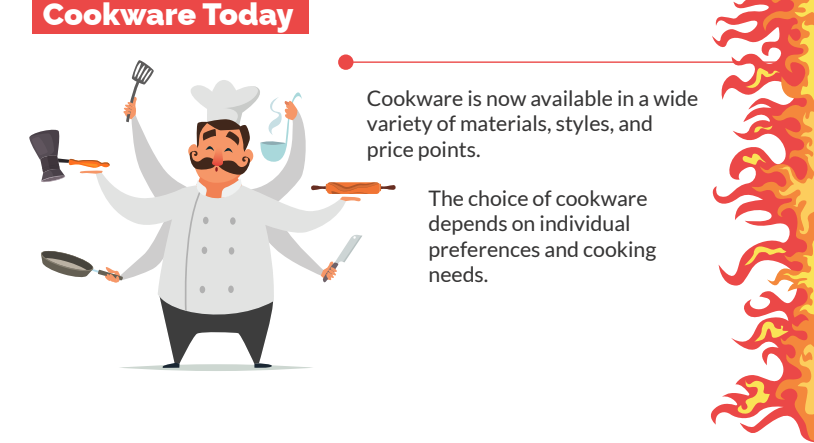
As you can see, the risks and benefits of certain materials can vary greatly depending on what you cook in them, as well as on your own personal dietary profile. Even the way you wash and dry your cookware can have an impact on how safe they are. One material that has a particularly contentious history is copper. Although loved by many chefs for its conducive properties, copper is actually poisonous in large quantities. As with iron, acidic foods are more likely to react with copper, which can lead to high doses of copper in the food. Does that mean you should avoid copper pots altogether? Not necessarily. Modern copper pots are lined with tin, providing a protective barrier against the copper itself. Old copper pots that have been passed down through the family, however, may not be lined, or the tin may have worn away, and they may need to be replaced. You can also keep your copper pots intact by washing them by hand, and by avoiding scourers with abrasive surfaces that can scratch off the tin lining. Don’t store any food in them overnight, keep an eye out for any damaged spots, and watch out for a metallic taste. The risks are low if you’re using modern cookware and know how to care for it. Copper toxicity is rare these days, although it was more common in the Victorian era. As Bee Wilson writes: “Cooks ignorant of the ill effects of copper actually sought out its greening powers, using unlined copper pans to make pickled green walnuts and green gherkins.”

Is teflon safe?
For many people, the concern about cooking surfaces comes down to one material: Teflon. First developed in France in 1954 under the brand name Tefal, nonstick pans are made with a chemical called polytetrafluoroethylene, or PTFE. PTFE is non-reactive, which means it doesn’t interact with the chemicals in your food, the way that copper or cast-iron does. “The reason food sticks to a pan is because proteins react with some metal ions at the surface,” writes Wilson. “To prevent food from sticking, you need to stop protein molecules from reacting with the surface in this way -- either by stirring it so vigilantly that it doesn’t get a chance to stick, or by introducing a protective layer between the food and the pan.” With cast-iron, that layer takes the form of an oil that’s used to “season” the pan. The more you cook, the more this layer fat builds up, creating a thick, non-reactive surface. With nonstick aluminum pans, that magic is created with PTFE. It’s a breeze to wash off, which makes it a go-to choice for frying eggs and other potentially sticky ingredients. However, some experts have raised concerns about Teflon, particularly PFOA, a chemical that was used to produce Teflon until 2013 and may be linked to cancer. According to Healthline, Teflon products have been free of PFOA since 2013, and are safe to use under normal conditions. The danger is when they’re heated to temperatures over 570°F (300°C), which is when the chemical coating breaks down.

You can prevent this from happening by adding oil before you heat up a non-stick pan, and by avoiding metal utensils and scouring pads that can scratch the surface.

What is the best cookware material?
Now that we’ve had a look at the history of cookware, and a few of the most common materials used in pots and pans, let’s take a closer look at the pros and cons of each one. Is there a single piece of cookware that can meet all your needs, or should you assemble your own batterie de cuisine like a Parisian chef? The short answer is that there isn’t one. It’s really a matter of personal preference, so what we want to do here is give you the information you need to make your own decision. At the 1988 Oxford Symposium on Food & Cookery, Chuck Lemme presented his thoughts on “The Ideal Pot.” An engineer by trade, he was determined to come up with a way to rank all of the characteristics of various types of cookware He sorted these characteristics into two categories: structural and surface properties. Its Structural properties: Strength, Density, Heat capacity, Conductivity, Thermal expansion. It's Surface properties: Wear resistance, Chip resistance, Corrosion resistance, Chemical reactivity, Adhesiveness to food. Then, he created a chart that weighted all of these characteristics to produce a possible score of up to 1000, which would represent the “Ideal Pot”. Which was the highest material on the list? Of single-metal pots, only cast-iron attained a score higher than 500. Stainless steel earned a score of 391.2, while copper came in at 411.8. Composite materials fared much better. A combination of nickel, aluminum, and stainless steel had the highest score, earning 734.0 out of a possible 1000 points. The catch? Lemme’s ideal pot -- a stainless steel and nickel alloy with a non-stick surface and an aluminum bottom layer -- doesn’t actually exist. To really understand what Lemme’s getting at, we need to go back to the basic principles of cooking. “All of cooking can be thought of as the transfer of heat from a source into food,” he says, “moderated by a pot.” In his view, the pot is at the center of the equation. There are three ways to transfer heat -- radiation, convection, and conduction -- all of which are bound by the Second Law of Thermodynamics. Essentially, the law states that heat moves from a hotter object to a cooler object, and not the other way around. Radiant heat transfer doesn’t require physical contact between the heat source and the object. Think of how a toaster browns your bread, or how an oven broiler crisps your meat. A charcoal grill also relies on radiant heat, at least partially, to cook your hamburger. The next type of heat transfer is convection. In this method, heat comes from the surrounding fluid, such as air or water, rather than from radiation. Convection ovens, including some toaster ovens, circulate air around the item being cooked in order to heat it more evenly. Convection is the preferred method for some types of baking, and is an optional setting on many conventional kitchen ovens. Finally, there’s heat transfer by conduction, which is the most relevant type of heat transfer to consider when choosing cookware. Conduction happens when the atoms in a substance vibrate so quickly that they pass on their energy to whatever comes into contact with them -- ideally your food, but if you aren’t careful, your cooking utensils or even your hand.

Before we go much further, let’s take a moment to review some of the most common cookware materials, and the pros and cons of each one.

Are copper pans good?
Copper is a popular choice among professional chefs, due to its high conductivity. Copper pots heat quickly and evenly, making it easier to control the temperature than other pots. They don’t take much time to warm up, but aren’t suitable for cooking over very high heat. Copper is reactive, so it has to be lined with tin or another metal in order to avoid toxicity. This also means you’ll need to clean and polish it carefully to keep it in good working order. When to use it: Copper pots are versatile, so you can use them for boiling and sauteeing on the stove, or put them in the oven to keep your food hot.

Are aluminum pans good?
Aluminum is a common material for frying pans and for many kinds of bakeware. Like copper, aluminum is a reactive metal, so it’s treated (anodized) to make it thicker and more stable. Aluminum conducts heat well, is lightweight, and is more durable than copper, making it easy to clean and care for. One downside to aluminum is that you can’t use it on an induction burner: it doesn’t contain enough magetic material to react with the magnetic coils. When to use: Aluminum pans are great for gas and electric stovetop cooking, from frying eggs to cooking meats and seafood. Aluminum bakeware can also be used in the oven.

Are stainless steel pans good?
Stainless steel is one of the most common materials for household dishware. It’s non-reactive, so you can cook almost anything in it, and it’s sturdy enough to clean in the dishwasher. The problem is that stainless steel doesn’t conduct heat very well, so some stainless steel pans are made with a copper or iron core to distribute heat more evenly. Also, unless it has a non-stick surface, food can stick to the bottom of the pan, so it’s important to stir frequently to avoid having to scrape food off later. When to use: Stainless steel is suitable for many straightforward tasks, such as boiling pasta or cooking soup, but less appropriate for sticky, slow-cooked dishes.

Should I buy a cast iron pan?
Cast iron skillets are great for dense, slow-cooked food, such as quiches and cornbreads. Its primary selling point is that it retains heat well, although it isn’t as conductive as copper. Cast iron takes a while to heat up, so if you have a larger pot and a small burner, the edges of your pan may stay cool. For the same reason, you’re less likely to burn your hand if you grab the handle of a cast-iron skillet, at least compared to other metal cookpots. The cons? Cast iron reacts with acidic foods, so tomato sauces aren’t a good fit. Cast iron pans are heavy, and slow to change temperature if you need to adjust it while cooking. It can take 10 minutes or more to heat up, and even longer to cool. Also, you need to care for it well, cleaning it gently with water. A properly-seasoned cast iron pan is almost as slick as a non-stick pan, and you can use metal utensils on it safely. When to use: Cast iron is suitable for frying, sauteeing, and even baking bread. It can go from the stovetop into the oven, and can be used over an open flame or campfire.

Is carbon steel cookware good?
Carbon steel may look like stainless steel, but has a lot in common with cast iron. Carbon steel is often used to make woks and frying pans, as well as some baking pans. Baking pans typically have a non-stick surface, but woks and frying pans don’t, so it’s important to season them just like you would a cast iron skillet. You can’t put them in the dishwasher, let them soak in the sink overnight, or clean them with abrasive soaps and scourers. When to use: Carbon steel frying pans can be used for crepes, omelets, and stir frys. Baking pans can be used for breads and cakes of all kinds.

What is the best enameled cast iron cookware?
Enameled cast iron usually comes in the form of a casserole pot or a Dutch oven. Since the cast iron is lined with an enamel coating, it doesn’t have to be seasoned, and you don’t have to avoid acidic dishes, as you do with standard cast iron. Otherwise, it retains many of the same properties as cast-iron. It’s slow to heat up, but it retains heat well, and can be used either on the stovetop or in the oven. When to use: Enameled cast iron is ideal for slow-cooked casseroles. You can use it for chilis, stews, and braises, or throw it in the oven to bake bread.

Who makes the best non-stick pans?
Non-stick pans don’t refer to a single material. In fact, they might be made with one of the other metals on this list, such as copper or aluminum, but are coated with a non-stick surface. This surface typically means you can cook with less oils than other pans require, and you don’t have to worry about food getting stuck. The downside is that the nonstick coating can get scratched off or break down under high heat, raising health concerns and reducing the pan’s durability. Only use plastic or wooden tools with nonstick pans, and replace the pan if the surface gets worn down. Also, the conductivity of the pan depends on what metal the interior is made of, not on what kind of chemical is on the surface, so heat transfer can vary widely. When to use: Use nonstick pans for delicate foods that can break easily or stick to other pans, such as eggs or crepes, or for acidic foods that can’t be cooked in cast iron.

One of the most recent changes in the history of cookware is the growing use of multiple layers, or “ply,” in order to get the best properties of each metal in a single item. While Lemme’s “ideal pot” may not exist, there are already many 3-ply, 5-ply, and even 7-ply pots on the market. For example, a 3-ply pan made of stainless steel and aluminum might use an aluminum core for even heat distribution, and a stainless steel exterior for easy cleaning. The magnetic qualities of stainless steel make it suitable for use on an induction stovetop. The multiple layers may not be visible to the naked eye, since the metals are chemically bonded together. But the more “ply” a pot has, the heavier and more expensive it will be.

How many ply cookware should I buy?
Some layers are more obvious, such as copper, which has a distinct color and is clearly visible in contrast with stainless steel. It’s common to find pots with copper bottoms and stainless steel sides, giving you the best qualities of both metals in one pot. Since copper and steel don’t bond together very well, there may also be a thin layer of aluminum between them. The more layers you get, though, the thinner each one will be, and the less impact they have on the conductivity of the pot. Some layers are simply used to bond other layers. Still, it’s important to distinguish between items that are properly cladded, or bonded together, and those that only have a copper disc on the bottom, which may be less effective at conducting heat.

What's the best cookware handle?
The properties that make up your cooking vessel don’t end with the cooking surface. The edge, handle, and lid of the pot all play a role in how your cookware functions. Most pots are designed with an “overcook edge” that allows the lid to sit tightly on the pot, while the lid has a “dripping edge” to prevent condensation from dripping off when it’s lifted. You’ll find a variety of lid designs, from flat stainless steel lids that prevent steam from escaping, to rounded glass lids with a tiny steam vent that’s perfect for cooking rice. Cast iron pans often come with cast iron lids, which may be rounded or octagonal in shape. The lid of your pan may not be made of the same material as the pan itself, so you may need to swap out lids depending on what you’re cooking. Using the right lid provides more control over the moisture content in your pan, although a tightly-fitting lid isn’t right for every recipe. For example, you may need to release steam in order to reduce a sauce, or to prevent a piece of fish from becoming too soggy. The material of the handle also plays a role in how easy the pan is to cook with. Some cast iron pans have cast iron handles, which heat up slowly, but get extremely hot. Because the pan and lid are very heavy, they may be impossible to pick up without a thick oven mitt.

Some pans have handles made out of synthetic materials, such as Bakelite, while many pot lids have handles made out of aluminum alloy or silicone that protect your hands from the heat. You can also create your own DIY grip out of heatproof materials.

Who invented copper cookware?
So far, we’ve looked at the history of various vessels and cooking techniques, but how exactly did we get here? Where do these materials come from, and how does it all get made? While technology has made it easier to mass produce pots and pans, plenty of cookware is still hand-made, either for practical or for cultural reasons. Take copper, for example. Copper is a malleable material that can be shaped easily, compared to metals like steel that only bend under high heat. Because of that, it was one of the first metals to become widely used, and was found in cultures as far apart as China, Egypt, and Mesopotamia as early as 4500 B.C. Historically, copper pots were lined with tin to prevent copper poisoning.

What did people cook with in the middle ages?
According to Jane Louise Kandur, “In our neighborhood in Istanbul, tinkers still come every year. They sit on the corner opposite the local grocers and polish and tin pots and pans for people.” If you wanted to, you could even make your own copper pots by hand. The process starts with a flat copper disk, which you can pickle to prevent oxidation. Then, you use a specially-designed “sinking hammer” to form the pot into shape, creating a lip around the edge of the disk. Once you’ve shaped the pot, you use a “planishing hammer” to smooth it out and remove any visible tool prints on the inside or outside of the pot. The pot is finishing by filing, sanding, and polishing, and by attaching a handle to it with a soldering torch. That’s still how many copper pots are made. Turkish coppersmiths have perfected the skill of making pots from a single piece of copper, while European techniques typically involve what’s called “dovetailing,” or joining multiple pieces of copper together with a cramp seam. You can still see the seams on old copper pots where the individual pieces have been joined; they have a distinct greenish “zig-zag” appearance.

Is silver lined cookware good?
Finally, let’s take a look at one last material that we haven’t talked about yet: silver, which is a less common, but still notable material used in the lining of some pans. Why silver? Silver conducts heat even faster than copper does, and it has a very high boiling point, making it suitable for high heat cooking.

Not sure if a pan you’ve inherited is lined with silver or tin? You can spot test it using vinegar, bleach, and copper cleaner to see how it reacts. Although some speciality pans are made entirely out of silver, they can be quite expensive, so it’s more common to find a silver lining on a copper pan.

If there’s one thing we can learn from the history of cookware, it’s that the development of new cooking methods is rarely linear. While some methods depended on new innovations -- French cooking couldn’t have developed the way it did without the closed range -- others have stayed largely the same for centuries, if not millennia.

That’s not to say there won’t be other unexpected developments, such as new approaches to nonstick surfaces, or advanced composite materials. But highly techical approaches, such as sous vide cooking and the Thermomix, still have limited appeal. We’re more likely to see a future focused on non-toxic, eco-friendly cooking materials, as well as colorful, stylish dishes like the Scandiavian casserole dishes by Dansk Kobenstyle. Ultimately, there are two things that matter most when deciding what cookware belongs in your kitchen. One, does it look good? And two, will you use it?
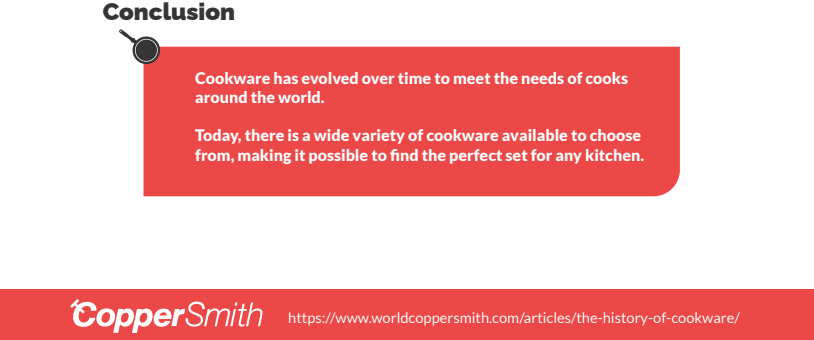
At the end of the day, everything else is just seasoning.
#WorldCopperSmith
Browse our collection of copper farmhouse sinks and custom range hoods here.

